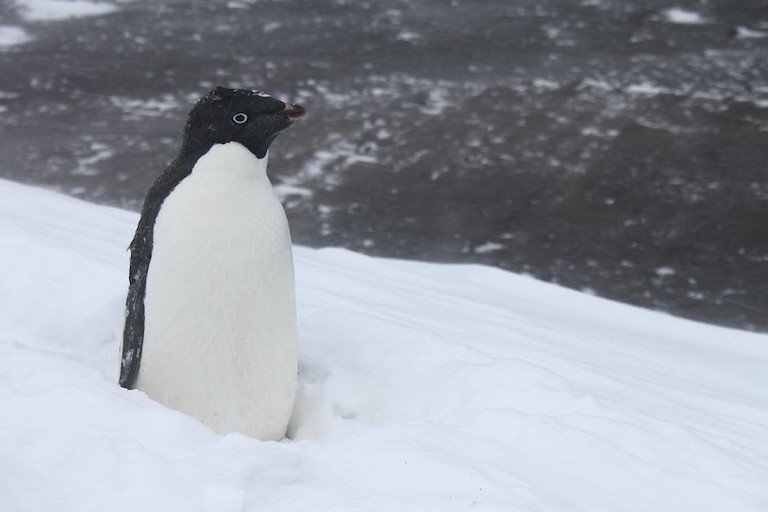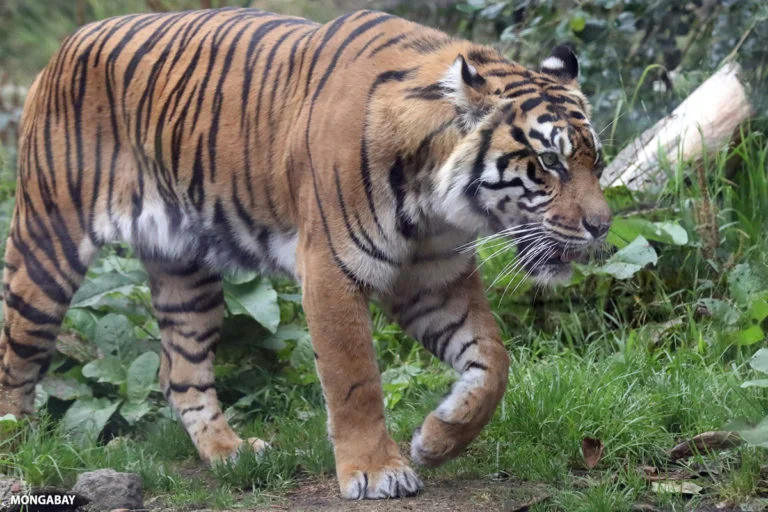- A study presents new evidence that microplastics are present in snow in Antarctica, one of the remotest places on Earth.
- Researchers collected snow samples at 19 sites across the Ross Ice Shelf in Antarctica, and found 29 microplastic particles per liter of melted snow — a higher amount than what was found in marine samples in Antarctica.
- The microplastics found in samples close to research stations were three times higher than what was found at other locations, prompting researchers to conclude that much of the plastic was coming from local clothing and equipment.
Plastic has been found in the most unexpected places: in the deepest parts of the ocean, in the remote mountain air, in human blood. And now, it’s even been found in snow in Antarctica.
A new study published in The Cryosphere is the first to document snow-bound microplastics — tiny particles measuring up to 5 millimeters, about the size of a short grain of rice — in a part of the world that’s long been considered to be one of the last remaining wilderness, still largely unaltered by human activity. This study, however, illustrates the unlikelihood that there are any places on Earth that haven’t been touched by plastic.
The researchers collected freshly fallen snow from 19 sites across the Ross Ice Shelf in Antarctica and found 29 microplastic particles per liter of melted snow, which is a higher concentration than what other scientists have found in samples taken from the Ross Sea as well as Antarctic sea ice, the study says.
Lead author Alex Aves, a Ph.D. student at the University of Canterbury in New Zealand, said she was “very surprised” to find microplastics in the snow samples. Both she and her supervisor, Laura Revell, an associate professor of environmental physics at the University of Canterbury and co-author of the paper, said they actually expected not to find any plastic on the Ross Ice Shelf due to its remoteness.
“It really just shows that microplastics are everywhere,” Aves told Mongabay in an email.
“It adds another pathway for microplastics to enter the environment and shows that terrestrial environments are just as exposed as marine environments to our pollution,” she added. “Once microplastics enter the environment they become available to organisms present and can enter the food chain, which has negative implications on health including changes to growth rates, reproduction and general biological functions.”
The researchers identified 13 kinds of plastic in their samples, the most common being polyethylene terephthalate (PET), the plastic used to make synthetic clothing, food packaging and bottles for personal care products. They surmised that most of the plastic came from outdoor clothing and equipment used by scientists and other personnel at the nearby research stations — in fact, they found that the concentrations of microplastics were three times higher in samples taken close to the research stations when compared to other samples. However, other microplastics may have originated from destinations farther afield, traveling up to 6,000 kilometers (3,700 miles) before reaching this part of Antarctica, the study says.
There’s a growing body of research looking at how land-sourced microplastics can be ejected into the atmosphere. For instance, one study found that microplastics found in the ocean, roads and agricultural fields are swept up into the air through wind and sea spray, and circulate through the world in a similar way to the biogeochemical cycles of water or nitrogen.
Natalie Welden, a lecturer in environmental science and sustainability at the University of Glasgow, who was not involved in the new research published in The Cryosphere, said the light, durable structure of plastic makes it an “ideal pollutant.”
“Microplastics (particularly fibres) also have the added characteristics of a high surface area to volume ratio, which means that they are both very low weight and have a comparatively large area for air currents to affect,” Welden told Mongabay in an email. “As a result, the wind can easily pick microplastics up and move them around. Once in the atmosphere they can either fall locally, due to their weight or with rain and snow, or be transported for long distances on global air currents. Added to the scale of waterborne transport and direct inputs from sewage, litter and other sources, there are few places that we don’t expect to find at least a few bits of plastic.”

She added the presence of synthetic fibers in the Antarctic snow samples was “very similar to that which we see closer to home.”
“We use synthetic textiles every day, and both daily wear and tear and frequent laundry processes can provide a direct route by which textile fibers can enter the environment,” Welden said. “Indeed, the authors highlight that, whilst some of the microplastics recovered could have traveled many thousands of miles, others could be from the various research stations on Ross Island itself.”
Other research has suggested that microplastics deposited on snow or ice in polar or alpine regions could accelerate the melting of the cryosphere. There are also concerns that microplastics emitted into the atmosphere could influence the climate by contributing to the formation of clouds.
Plastic has become so ubiquitous in the world that some scientists argue that we have breached the planetary boundary for chemical pollution, destabilizing the Earth and pushing humanity down a dangerous path.
Aves said there’s still much to learn about microplastics in our environment, including the implications for human health, and how microplastics can influence climate processes.
“Understanding the history and global movement of microplastics and their direct impacts on remote regions such as Antarctica is all of huge importance,” Aves said. “There are still many unknowns in this field that require continued research to understand the full extent of this problem and the best solutions to tackling such a widespread issue.”

Welden said that as long as plastic production increases, so will the amount of microplastics in our environment, even in far-flung places like Antarctica.
“The levels of microplastic that we currently see in areas of high plastic input or accumulation today, such as close to coastal cities and in the garbage patches of our oceans, may be indicative of what we can expect in remote and potentially sensitive environments in the near future,” Welden said. “We need a more considered use of these materials to be able to gain the benefits from their impressive properties without saturating our environment with plastics, and we need to make sustainable changes soon.”
Citations:
Aves, A. R., Revell, L. E., Gaw, S., Ruffell, H., Schuddeboom, A., Wotherspoon, N. E., … McDonald, A. J. (2022). First evidence of microplastics in Antarctic snow. The Cryosphere, 16(6), 2127-2145. doi:10.5194/tc-16-2127-2022
Evangeliou, N., Grythe, H., Klimont, Z., Heyes, C., Eckhardt, S., Lopez-Aparicio, S., & Stohl, A. (2020). Atmospheric transport, a major pathway of microplastics to remote regions. Nature Communications, 11(1). doi:10.1038/s41467-020-17201-9
Ganguly, M., & Ariya, P. A. (2019). Ice nucleation of model nanoplastics and microplastics: A novel synthetic protocol and the influence of particle capping at diverse atmospheric environments. ACS Earth and Space Chemistry, 3(9), 1729-1739. doi:10.1021/acsearthspacechem.9b00132
Persson, L., Carney Almroth, B. M., Collins, C. D., Cornell, S., De Wit, C. A., Diamond, M. L., … Hauschild, M. Z. (2022). Outside the safe operating space of the planetary boundary for novel entities. Environmental Science & Technology. doi:10.1021/acs.est.1c04158
Banner image caption: Snow storm in Antarctica. Image by Eli Duke / Flickr (CC BY-SA 2.0).
Elizabeth Claire Alberts is a staff writer for Mongabay. Follow her on Twitter @ECAlberts.
FEEDBACK: Use this form to send a message to the author of this post. If you want to post a public comment, you can do that at the bottom of the page.











